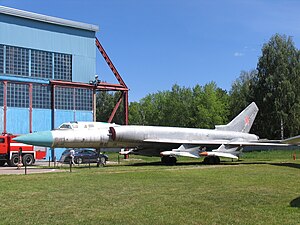Loading AI tools
Soviet interceptor aircraft From Wikipedia, the free encyclopedia
The Tupolev Tu-28 (NATO reporting name Fiddler) is a long-range interceptor aircraft introduced by the Soviet Union in the 1960s. The official designation was Tu-128,[2] but this designation was less commonly used in the West. It was the largest and heaviest fighter[nb 1] ever in service.[2][3]
| Tu-28/Tu-128 | |
|---|---|
 Tu-128 at the Central Air Force Museum at Monino, Russia | |
| General information | |
| Type | Interceptor |
| Manufacturer | Voronezh Aircraft Production Association |
| Designer | Tupolev |
| Primary user | Soviet Air Defence Forces |
| Number built | 198[1] (including 10 trainers) |
| History | |
| Introduction date | 1964[1] (or 1966[2]) |
| First flight | 18 March 1961 |
| Retired | 1990 |
| Developed from | Tupolev Tu-98 |
In the 1950s, the Soviet Union sought means to defend against nuclear-armed American bombers possibly penetrating its borders (especially its long and vulnerable northern border). Contemporary interceptors, such as the Yakovlev Yak-28P, were able to cover a radius of just a few hundred kilometers[1][4][5] flying from northern Soviet bases like Talagi and Savatiya;[6][7][8] the newly developed surface-to-air missiles had even shorter range.[1] Considering both, the sheer numbers required to defend a 5,000 km air front[nb 2] were economically impossible to maintain. This left the Soviet Union able to provide a modern air defense only for selected valuable areas.[5] The PVO decided to cover the entire territory, but with a looser defence. In 1955 it placed a requirement for a large area-defense interceptor, that would achieve it with sparse[nb 3] airbases. The PVO requirement called for a supersonic aircraft with enormous fuel tanks for both a good patrol time and long range, a capable radar, and the most powerful air-to-air missiles possible. The first attempt, although unsuccessful, was the Lavochkin La-250, a 30-tonne interceptor prototype which was[5] the last of the Lavochkin design bureau's aircraft.

Iosif Nezval[2][5] of Tupolev Design Bureau led development of the new interceptor aircraft. The work began in 1958, based on an existing single prototype of the unsuccessful Tu-98 supersonic bomber. The military designation of the interceptor was at first Tu-28, but it was changed in 1963 to Tu-128, identical to the designation used by the OKB.[1][2][5]
The Tu-128 had a broad, low/mid-mounted swept wing carrying the main landing gear in wing-mounted pods, and slab tailplanes. Two Lyulka AL-7F-2 turbojet engines[1][2] were mounted in the fuselage. The two-man crew of pilot and navigator were seated in tandem.
The Tu-128, with its maximum weight of 43 tonnes, was the heaviest fighter to enter service.[nb 1][2] A pure interceptor with high wing loading, unsophisticated but reliable avionics, and poor visibility, it was not an agile aircraft[2] and was intended only to engage NATO bombers like the B-52,[2][5] not dogfight smaller aircraft.
The interceptor made its initial public appearance in the 1961 Tushino air parade. Western experts, unaware that the bulge on the belly carried testing instruments, mistook it for a large ventral radar for a mixed interceptor/AWACS role.[3] The production version lacked the bulge and had a large nose radome housing a radar, known as RP-S[nb 4] Smerch, having a detection range of about 50 km (31 mi[2]) and a lock-on range of about 40 km (25 mi).[1]
Armament of the Tu-128 was four Bisnovat R-4 air-to-air missiles (known as K-80 during development;[1] NATO reporting name AA-5 'Ash'). Usually two of them were R-4Rs with semi-active radar homing and two were R-4T infrared-homing missiles, with the former on the outer pylons and the latter on the inner underwing pylons. There was no internal weapons bay.
Production of the Tu-128 ended in 1970 with a total of 198 aircraft having been built.[1][9]
Development of various projects designated Tu-28A, Tu-28-80, Tu-28-100, Tu-138, and Tu-148 were proposed by the Tupolev Design Bureau but all were abandoned.[1]
The Tu-128's only publicly reported combat operation was the destruction of NATO reconnaissance balloons. The aircraft remained in service until 1990.[1][2] Through the 1980s, units armed with the Tu-128 converted to the Mikoyan MiG-31,[1][3] which features more advanced sensors and weapons.[10]


Data from Tupolev: The Man and His Aircraft[2]
General characteristics
Performance
Armament
Related development
Aircraft of comparable role, configuration, and era
Related lists
Seamless Wikipedia browsing. On steroids.
Every time you click a link to Wikipedia, Wiktionary or Wikiquote in your browser's search results, it will show the modern Wikiwand interface.
Wikiwand extension is a five stars, simple, with minimum permission required to keep your browsing private, safe and transparent.